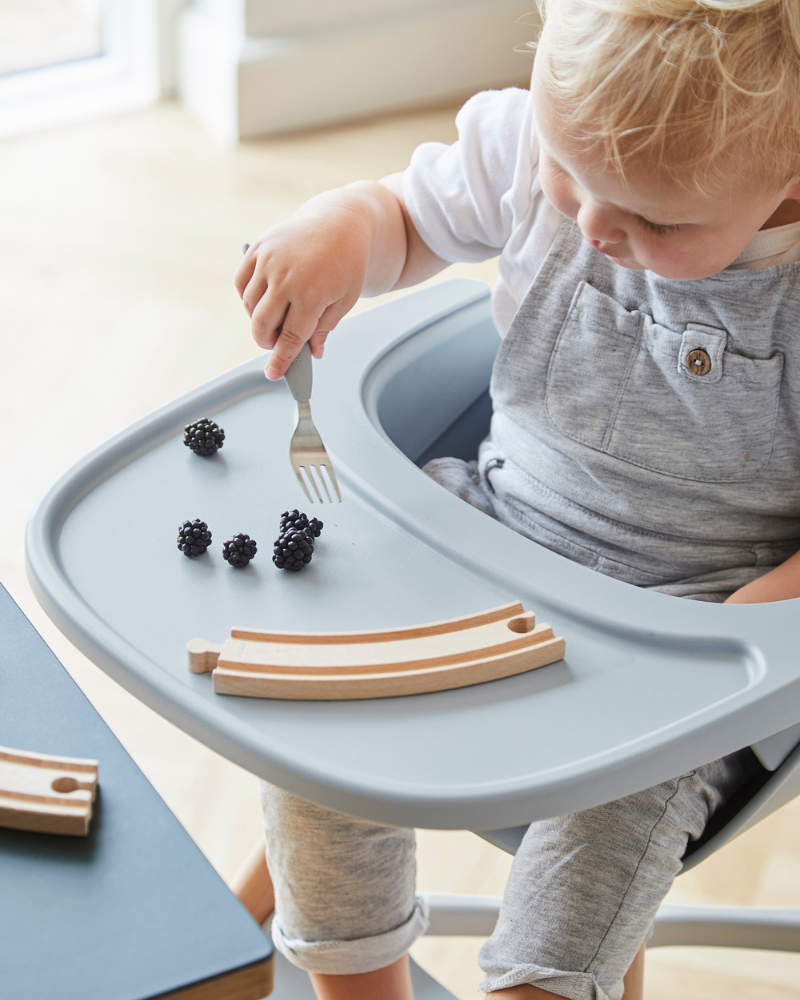
To introduce the Montessori method to your weaning routine, the first place to start is initialising respect between you, baby, and your environment. This all comes down to showing your infant respect, and in turn they learn respect and care for their environment early on.
As they observe their surroundings, the parent must observe their little one and follow their lead. This means looking for signs that your baby is ready to start the weaning process.
Below we have listed some tips to help you start, and make a note of:
1. Feeding table
Infants learn through their eyes and copy their surroundings. It’s a great idea to find a highchair that adapts as they grow. While your little one is a baby, a highchair that elevates them to the family table to join mealtimes is essential. Here your baby can learn through observation and watch how you eat! They need to see how you use your hands, your movements, chewing and tasting your food.
Once they are older, a lower table and chair is great because it allows independence once they are mobile. Toddlers can set their own table and clear their own dishes – which is extra special to witness!
Our newest addition to Cheeky Rascals is the Ziza Highchair. With the Short Legs accessory, you can adapt this highchair to a play chair – perfect for your little one to learn weaning independence!
2. Loading their spoon
If you are feeding them, it’s great to give them their own spoon and fork. If you give them a spoon from the start (around 6 months) they will end up automatically taking the spoon – and will have a good try at feeding themselves. You can dip their spoon into the bowl and feed them but it would be great to encourage them to practice this themselves. Overtime you can load their spoon and place it next to their bowl, and they can transition to feed themselves.
Tip: we suggest starting with thick food which is easy to scoop, and then moving to finger food in baby-led weaning style.
The Baby Brezza Food Maker Deluxe is the perfect one step weaning machine which prepares, steams and cooks all food in one place. No transferring food around the kitchen…so no mess!


3. Throwing their food
Supervising their feeding is essential, especially as this can prevent them getting in a throwing habit if you are near-by to stop this – before it escalates. Once they start throwing their food, you can give them one more chance, then it’s over. It’s often a sign that they are no longer hungry, and would rather play with their food than eat. This will eventually teach the child to respect their environment, as we must embrace the mess on the way!
4. Real dishes and glasses
We love the idea of the child using real utensils and sets; however, supervision is necessary. Ramekin dishes are great as food as pressed up against the edge, rather than falling off the plate. A small spoon and fork give them practice with the same utensils that we use, as well does an open glass. Using an open glass is great as it allows the child to see the natural consequences when the cup is dropped. We would also recommend a glass, duralex glass – this should not shatter when dropped.
Tip: keep a pitcher near-by, as there will be plenty of spills!
5. Have patience and good communication
Involving your little one into the conversation from as early as possible is great, as this will allow the child to feel empowered and included in mealtimes. Using baby sign will match words up with visuals and is a great learner for you to understand what your little one wants. Giving your child the opportunity to communicate with you, early in the weaning process, will result in them being in control of mealtimes and taking that independence one step further.
But in patient, feeding a baby can be frustrating. Just remain calm and take your time, it should never feel rushed. Sometimes its impossible to go at the child’s pace, but this is something you should aim for.






